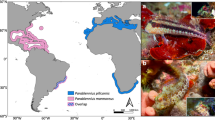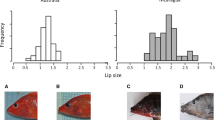Abstract
Recent genetic studies indicate that species with very close phenotypic similarity (“cryptic species”) are a common feature of nature, and that such cryptic species often coexist in communities. Because traditional views of species coexistence demand that species differ in phenotype to coexist stably, the existence of sympatric cryptic species appears to challenge traditional perspectives of coexistence. We evaluated niche diversity in three recently discovered species of Hyalella amphipods that occur sympatrically in lakes and share close phenotypic similarity. We found that, in some cases, these species exhibited strong complementary spatial distributions within the littoral zone of lakes, both across a distance-from-shore gradient, and a vertical depth gradient. Additionally, we compared fish stomach contents with habitat samples and found that species differed in their vulnerability to predation from sunfish (Lepomis spp.). Complementarity among species across axes of spatial distribution and predation risk, two important niche components, suggests that species with close phenotypic similarity may differ appreciably along ecologically relevant axes. Our results, considered in the light of previous studies, suggest a community structured by predator-mediated coexistence or sequential dominance across environmental gradients in the littoral zone.




Similar content being viewed by others
References
Amarasekare P, Nisbet RM (2001) Spatial heterogeneity, source-sink dynamics, and the local coexistence of competing species. Am Nat 158:572–584
Armstrong RA (1979) Prey species replacement along a gradient of nutrient enrichment: a graphical approach. Ecology 60:76–84
Bohannan BJM, Lenski RE (1999) Effect of prey heterogeneity on the response of a model food chain to resource enrichment. Am Nat 153:73–82
Bousfield EL (1996) A contribution to the reclassification of Neotropical freshwater hyalellid amphipods (Crustacea: Gammaridea, Talitroidea). Boll Mus Civ Storia Nat Verona 20:175–224
Brown JS, Kotler BT, Mitchell WA (1994) Foraging theory, patch use, and the structure of a Negev desert granivore community. Ecology 75:2286–2300
Chase JM, Leibold MA (2003) Ecological niches: linking classical and contemporary approaches. University of Chicago Press, Chicago, Ill.
Chesson J (1983) The estimation an analysis of preference and its relationship to foraging models. Ecology 64:1297–1304
Chesson P (2000) Mechanisms of maintenance of species diversity. Annu Rev Ecol Syst 31:343–366
Edwards TD, Cowell BC (1992) Population dynamics and secondary production of Hyalella azteca (Amphipoda) in Typha stands of a subtropical Florida lake. J North Am Benthol Soc 11:69–79
Gomez A, Serra M, Carvalho GR, Lunt DH (2002) Speciation in ancient cryptic species complexes: evidence from the molecular phylogeny of Branchionus plicatilis (Rotifera). Evolution 56:1431–1444
Hebert PDN, Penton EH, Burns JM, Janzen DH, Hallwachs W (2004) Ten species in one: DNA barcoding reveals cryptic species in neotropical skipper butterfly Astraptes fulgerator. Proc Natl Acad Sci 101:14812–14817
Hogg ID, Stevens MI, Schnabel KE, Chapman MA (2006) Deeply divergent lineages of the widespread New Zealand amphipod Paracalliope fluviatilis revealed using allozyme and mitochondrial DNA analysis. Freshwater Biol 51:236–248
Holt RD, Grover J, Tilman D (1994) Simple rules for interspecific dominance in systems with exploitative and apparent competition. Am Nat 144:741–771
Hubbell SP, Foster RB (1986) Biology, chance, and history and the structure of tropical rain forest tree communities. In: Diamond J, Case TJ (eds) Community ecology. Harper and Row, New York, pp 314–299
Leibold MA (1996) A graphical model of keystone predators in food webs: trophic regulation of abundance, incidence, and diversity patterns in communities. Am Nat 147:784–812
Leibold MA (1998) Similarity and local co-existence of species in regional biotas. Evol Ecol 12:95–110
Leibold MA, McPeek MA (2006) Coexistence of the niche and neutral perspectives in community ecology. Ecology 87:1399–1410
Losos JB (1994) Integrative approaches to evolutionary ecology: Anolis lizards as model systems. Annu Rev Ecol Syst 25:467–493
MacArthur RH (1972) Geographical ecology. Princeton University Press, Princeton, N.J.
Matthews LM (2006) Cryptic biodiversity and phylogeographical patterns in a snapping shrimp. Mol Ecol 15:4049–4063
McPeek MA, Gomulkiewicz R (2005) Assembling and depleting species richness in metacommunities: insights from ecology, population genetics, and macroevolution. In: Holyoak M, Leibold MA, Holt RD (eds) Metacommunities: spatial dynamics and ecological communities. University of Chicago Press, Chicago, Ill. pp 355–373
Menge BA, Berlow EL, Blanchette CA, Navarrete SA, Yamada SB (1994) The keystone species concept: variation in interaction strength in a rocky intertidal habitat. Ecol Monogr 64:249–286
Mills CS, Soule ME, Doak DF (1993) The keystone species concept in ecology and conservation. BioScience 43:219–224
Molbo D, Machado CA, Sevenster JG, Keller L, Herre EA (2003) Cryptic species of fig-pollinating wasps: implications for the evolution of the fig-wasp mutualism, sex allocation, and precision of adaptation. Proc Natl Acad Sci 100:5867–5872
Mouquet N, Loreau M (2003) Community patterns in source–sink metacommunities. Am Nat 162:544–557
Muller J (2000) Mitochondrial DNA variation and the evolutionary history of cryptic Gammarus fossarum types. Mol Phylogenet Evol 15:260–268
Nicholls B, Racey P (2006) Contrasting home-range size and spatial partitioning in cryptic and sympatric pipistrelle bats. Behav Ecol Sociobiol 61:131–142
Organ JA (1961) Studies of the local distribution, life history, and population dynamics of the salamander genus Desmognathus in Virginia. Ecol Monogr 31:189–220
Paine RT (1966) Food web complexity and species diversity. Am Nat 100:65–75
Pickard DP, Benke AC (1996) Production dynamics of Hyalella azteca (Amphipoda) among different habitats in a small wetland in southeastern USA. J North Am Benthol Soc 15:537–550
Shmida A, Ellner S (1984) Coexistence of plant species with similar niches. Vegetation 58:29–55
Skelly DK (1995) A behavioral trade-off and its consequences for the distribution of Pseudacris treefrog larvae. Ecology 76:150–164
Smiley EA, Tessier AJ (1998) Environmental gradients and the horizontal distribution of microcrustaceans in lakes. Freshwater Biol 39:397–409
Sokal RR, Rohlf FJ (1995) Biometry, 3rd edn. Freeman, New York
Stuart B, Inger R, Voris HK (2006) High level of cryptic species diversity revealed by sympatric lineages of Southeast Asian forest frogs. Biol Lett 2:470–474
Tessier AJ, Leibold M (1997) Habitat use and ecological specialization within lake Daphnia populations. Oecologia 109:561–570
Tilman D (1982) Resource competition and community structure. Princeton University Press, Princeton, N.J.
Vance RR (1974) Predation and resource partitioning in one predator-two prey model communities. Am Nat 112:797–813
Wellborn GA (1994a) Size-biased predation and the evolution of prey life histories: a comparative study of freshwater amphipod populations. Ecology 75:2104–2117
Wellborn GA (1994b) The functional basis of body size differences between Hyalella (Amphipoda) species. J Freshwater Ecol 9:159–168
Wellborn GA (2002) Tradeoff between competitive ability and antipredator adaptation in a freshwater amphipod species complex. Ecology 83:129–136
Wellborn GA, Cothran RD (2004) Phenotypic similarity and differentiation among sympatric cryptic species in a freshwater amphipod species complex. Freshwater Biol 49:1–13
Wellborn GA, Skelly DK, Werner EE (1996) Mechanisms creating community structure across a freshwater habitat gradient. Annu Rev Ecol Syst 27:337–363
Wellborn GA, Cothran RD, Bartholf S (2005) Life history and allozyme diversification in regional ecomorphs of the Hyalella azteca (Crustacea: Amphipoda) species complex. Biol J Linn Soc 84:161–175
Werner EE, McPeek MA (1994) Direct and indirect effects of predators on two anuran species along an environmental gradient. Ecology 75:1368–1382
Wetzel RG (1983) Limnology, 2nd edn. Saunders College Publishing, New York
Witt JDS, Hebert PDN (2000) Cryptic species diversity and evolution in the amphipod genus Hyalella within central glaciated North America: a molecular phylogenetic approach. Can J Fish Aquat Sci 57:687–698
Witt JDS, Threloff DL, Hebert PDN (2006) DNA barcoding reveals extraordinary cryptic diversity in an amphipod genus: implications for desert spring conservation. Mol Ecol 15:3073–3082
Zhang D-Y, Lin K, I Hanski (2004) Coexistence of cryptic species. Ecol Lett 7:165–169
Acknowledgements
We thank Christine Relyea for help with field collections. The manuscript was improved by insightful comments from John White, Dan Allen, Puni Jeyasingh, and Matt Chumchal. Our work was supported by the National Science Foundation.
Author information
Authors and Affiliations
Corresponding author
Additional information
Communicated by Carla Caceres.
Rights and permissions
About this article
Cite this article
Wellborn, G.A., Cothran, R.D. Niche diversity in crustacean cryptic species: complementarity in spatial distribution and predation risk. Oecologia 154, 175–183 (2007). https://doi.org/10.1007/s00442-007-0816-x
Received:
Accepted:
Published:
Issue Date:
DOI: https://doi.org/10.1007/s00442-007-0816-x




